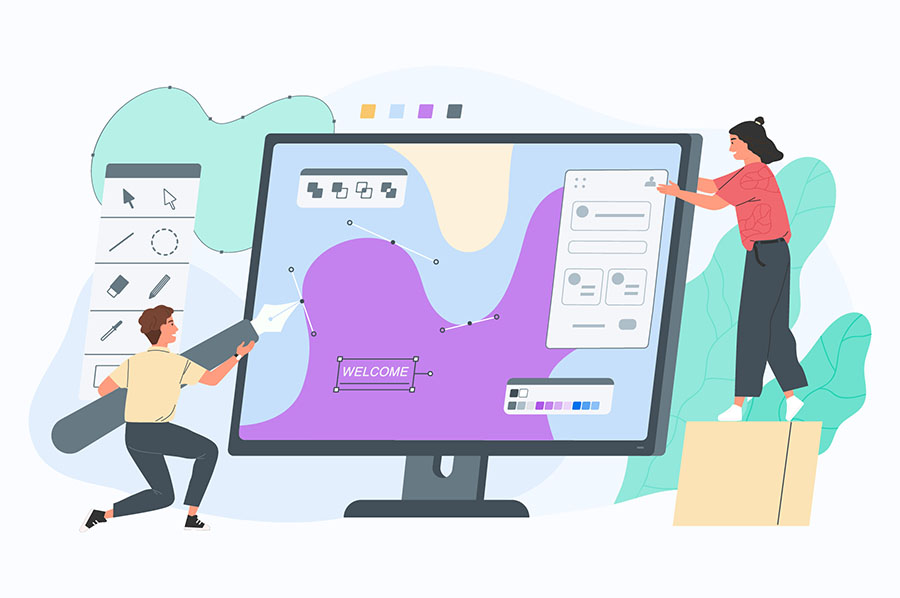All Categories
Featured
Table of Contents
- – Web Design Services + Website Development Agen...
- – Powderkeg: Web Design Madison, Wi Tips and Tr...
- – Web Design Definition - Techterms Tips and Tr...
- – Web Design Software By Xara Tips and Tricks:
- – What Is Web Design? - Interaction Design Foun...
- – Top Web Design Courses Online - Updated [Apri...
- – Web Design Services By Freelance Website Des...
- – Trajectory: Atlanta Web Design Company Tips ...
- – Otc Web Design Girdwood, Alaska - Web Design...
- – Responsive Design Best Practices - Google Se...
- – Web Design - Wikipedia Tips and Tricks:
Web Design Services + Website Development Agency Tips and Tricks:
Quick summary Usability and the energy, not the visual design, identify the success or failure of a website. Considering that the visitor of the page is the only individual who clicks the mouse and therefore chooses everything, user-centric design has actually developed as a standard method for successful and profit-oriented website design - web design frederick md.
and the energy, not the visual style, figure out the success or failure of a site. Given that the visitor of the page is the only individual who clicks the mouse and therefore chooses everything, user-centric design has ended up being a standard technique for successful and profit-oriented website design. If users can't utilize a function, it might as well not exist.
g. where the search box should be put) as it has actually already been carried out in a variety of short articles; rather we concentrate on the methods which, utilized properly, can result in more sophisticated style choices and streamline the process of viewing presented details. Please see that you might be thinking about the usability-related articles we have actually released prior to: Principles Of Good Website Design And Reliable Website Design Standards, In order to utilize the concepts correctly we initially require to understand how users interact with websites, how they believe and what are the standard patterns of users' habits.
Powderkeg: Web Design Madison, Wi Tips and Tricks:
Visitors glimpse at each new page, scan some of the text, and click the first link that captures their interest or slightly looks like the thing they're searching for. There are big parts of the page they don't even look at. A lot of users look for something intriguing (or beneficial) and clickable; as quickly as some appealing prospects are found, users click.
If a page provides users with high-quality material, they want to compromise the material with ads and the style of the site. This is the reason not-that-well-designed websites with premium material acquire a lot of traffic over years. Material is more essential than the style which supports it.

Users don't read, they scan. Notice how "hot" locations abrupt in the middle of sentences. This is normal for the scanning procedure. Really simple principle: If a website isn't able to fulfill users' expectations, then designer stopped working to get his task done effectively and the business loses cash. The greater is the cognitive load and the less user-friendly is the navigation, the more willing are users to leave the site and search for alternatives.
Web Design Definition - Techterms Tips and Tricks:
Neither do they scan web page in a linear fashion, going sequentially from one website area to another one. Rather users satisfice; they select the very first reasonable option. As quickly as they find a link that seems like it may result in the objective, there is an excellent possibility that it will be instantly clicked.
It does not matter to us if we comprehend how things work, as long as we can use them. If your audience is going to act like you're developing billboard, then design fantastic billboards." Users desire to be able to manage their web browser and rely on the constant data discussion throughout the site.
If the navigation and website architecture aren't instinctive, the number of enigma grows and makes it harder for users to understand how the system works and how to get from point A to point B. A clear structure, moderate visual clues and quickly identifiable links can help users to discover their path to their goal.
Web Design Software By Xara Tips and Tricks:

claims to be "beyond channels, beyond items, beyond circulation". What does it imply? Because users tend to explore sites according to the "F"-pattern, these 3 statements would be the very first elements users will see on the page once it is packed. The style itself is simple and intuitive, to understand what the page is about the user needs to search for the response.
Once you have actually attained this, you can communicate why the system is useful and how users can gain from it. People won't utilize your website if they can't find their method around it. 2. Do Not Squander Users' Perseverance, In every task when you are going to offer your visitors some service or tool, attempt to keep your user requirements minimal.
First-time visitors want to, not filling long web types for an account they may never use in the future. Let users check out the site and find your services without forcing them into sharing private information. It's not affordable to require users to get in an email address to test the feature.
What Is Web Design? - Interaction Design Foundation (Ixdf) Tips and Tricks:
And that's what you want your users to feel on your web website. The registration can be done in less than 30 seconds as the type has horizontal orientation, the user does not even require to scroll the page.
A user registration alone suffices of an obstacle to user navigation to minimize inbound traffic. 3. Handle To Focus Users' Attention, As websites offer both fixed and dynamic material, some elements of the interface attract attention more than others do. Undoubtedly, images are more attractive than the text simply as the sentences marked as bold are more attractive than plain text.
Focusing users' attention to specific locations of the website with a moderate usage of visual aspects can help your visitors to obtain from point A to point B without thinking about how it really is supposed to be done. The less enigma visitors have, the they have and the more trust they can establish towards the company the website represents.
Top Web Design Courses Online - Updated [April 2022] - Udemy Tips and Tricks:
Make Every Effort For Function Exposure, Modern web styles are typically criticized due to their approach of guiding users with aesthetically appealing 1-2-3-done-steps, big buttons with visual effects and so on. From the style perspective these elements really aren't a bad thing.
The website has 9 main navigation options which show up at the first glance. The option of colors might be too light, though. is a fundamental concept of successful user interface design. It does not really matter how this is achieved. What matters is that the content is well-understood and visitors feel comfortable with the method they engage with the system.
com gets straight to the point. No adorable words, no exaggerated statements. Rather a price: just what visitors are searching for. An ideal solution for efficient writing is touse short and succinct phrases (come to the point as quickly as possible), use scannable layout (categorize the content, utilize numerous heading levels, use visual aspects and bulleted lists which break the flow of consistent text blocks), usage plain and objective language (a promo doesn't require to sound like ad; offer your users some sensible and objective reason they must utilize your service or remain on your site)6.
Web Design Services By Freelance Website Designers - Fiverr Tips and Tricks:
Users are hardly ever on a site to enjoy the design; moreover, in many cases they are trying to find the info despite the style - web design frederick md. Aim for simpleness rather of intricacy. From the visitors' point of view, the very best site design is a pure text, without any ads or further content obstructs matching precisely the question visitors used or the content they have actually been looking for.
Finch plainly provides the information about the website and provides visitors a choice of choices without overcrowding them with unnecessary content. 7. Don't Hesitate Of The White Space, Actually it's actually difficult to overstate the value of white area. Not just does it help to for the visitors, but it makes it possible to perceive the info provided on the screen.
Complex structures are more difficult to read, scan, analyze and deal with. If you have the choice between separating two design sectors by a visible line or by some whitespace, it's typically better to utilize the whitespace option. (Simon's Law): the much better you manage to provide users with a sense of visual hierarchy, the easier your material will be to view.
Trajectory: Atlanta Web Design Company Tips and Tricks:
The same conventions and rules need to be used to all elements.: do the most with the least quantity of cues and visual aspects. Four significant points to be considered: simpleness, clarity, distinctiveness, and focus. Simpleness includes only the aspects that are crucial for interaction. Clearness: all components ought to be designed so their meaning is not ambiguous.
Conventions Are Our Pals, Conventional design of site components does not result in a boring web site. It would be an usability nightmare if all websites had different visual presentation of RSS-feeds.
understand what they're getting out of a site navigation, text structure, search placement etc. A common example from use sessions is to equate the page in Japanese (presuming your web users do not know Japanese, e. g. with Babelfish) and provide your functionality testers with a task to find something in the page of different language.
Otc Web Design Girdwood, Alaska - Web Design & Google ... Tips and Tricks:
Test Early, Test Frequently, This so-called TETO-principle must be used to every web design project as use tests typically supply into considerable issues and concerns related to a provided layout. Test not too late, not too little and not for the wrong reasons.
Some important points to bear in mind: according to Steve Krug, and testing one user early in the project is better than screening 50 near completion. Accoring to Boehm's first law, mistakes are most frequent throughout requirements and style activities and are the more costly the later on they are removed.
That suggests that you design something, test it, repair it and then evaluate it once again. There may be issues which haven't been found during the very first round as users were almost obstructed by other issues. functionality tests. Either you'll be pointed to the issues you have or you'll be pointed to the absence of significant design flaws which is in both cases a beneficial insight for your task.
Responsive Design Best Practices - Google Search Central Tips and Tricks:

This holds for designers. After you've worked on a website for few weeks, you can't observe it from a fresh point of view anymore. You understand how it is developed and for that reason you know exactly how it works you have the wisdom independent testers and visitors of your site wouldn't have.
It can be connected to other locations such as graphic design, user experience, and multimedia arts, however is more aptly seen from a technological perspective. It has actually ended up being a big part of people's daily lives. It is tough to imagine the Internet without animated graphics, different designs of typography, background, videos and music.

During 1991 to 1993 the World Wide Web was born. Text-only pages might be viewed using a simple line-mode web browser. There had actually been no integrated technique to graphic style aspects such as images or noises.
Web Design - Wikipedia Tips and Tricks:
The W3C was developed in October 1994 to "lead the Internet to its full capacity by developing common procedures that promote its development and ensure its interoperability." This prevented any one company from monopolizing a propriety web browser and shows language, which could have modified the result of the Internet as a whole.
As this has actually taken place the innovation of the web has actually likewise moved on. There have also been considerable modifications in the method people use and access the web, and this has actually changed how sites are created.
Learn more about Lovell Media Group LLC or TrainACETable of Contents
- – Web Design Services + Website Development Agen...
- – Powderkeg: Web Design Madison, Wi Tips and Tr...
- – Web Design Definition - Techterms Tips and Tr...
- – Web Design Software By Xara Tips and Tricks:
- – What Is Web Design? - Interaction Design Foun...
- – Top Web Design Courses Online - Updated [Apri...
- – Web Design Services By Freelance Website Des...
- – Trajectory: Atlanta Web Design Company Tips ...
- – Otc Web Design Girdwood, Alaska - Web Design...
- – Responsive Design Best Practices - Google Se...
- – Web Design - Wikipedia Tips and Tricks:
Latest Posts
Figma: The Collaborative Interface Design Tool. Tips and Tricks:
Website Design - Best Ecommerce Web Design By Shopify Tips and Tricks:
What Is A Web Designer? (2022 Guide) - Brainstation® Tips and Tricks:
More
Latest Posts
Figma: The Collaborative Interface Design Tool. Tips and Tricks:
Website Design - Best Ecommerce Web Design By Shopify Tips and Tricks:
What Is A Web Designer? (2022 Guide) - Brainstation® Tips and Tricks: